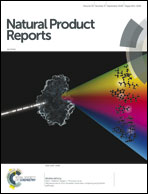Diversity of biologically active secondary metabolites from endophytic and saprotrophic fungi of the ascomycete order Xylariales†
Abstract
Covering: up to December 2017
The diversity of secondary metabolites in the fungal order Xylariales is reviewed with special emphasis on correlations between chemical diversity and biodiversity as inferred from recent taxonomic and phylogenetic studies. The Xylariales are arguably among the predominant fungal endophytes, which are the producer organisms of pharmaceutical lead compounds including the antimycotic sordarins and the antiparasitic nodulisporic acids, as well as the marketed drug, emodepside. Many Xylariales are “macromycetes”, which form conspicuous fruiting bodies (stromata), and the metabolite profiles that are predominant in the stromata are often complementary to those encountered in corresponding mycelial cultures of a given species. Secondary metabolite profiles have recently been proven highly informative as additional parameters to support classical morphology and molecular phylogenetic approaches in order to reconstruct evolutionary relationships among these fungi. Even the recent taxonomic rearrangement of the Xylariales has been relying on such approaches, since certain groups of metabolites seem to have significance at the species, genus or family level, respectively, while others are only produced in certain taxa and their production is highly dependent on the culture conditions. The vast metabolic diversity that may be encountered in a single species or strain is illustrated based on examples like Daldinia eschscholtzii, Hypoxylon rickii, and Pestalotiopsis fici. In the future, it appears feasible to increase our knowledge of secondary metabolite diversity by embarking on certain genera that have so far been neglected, as well as by studying the volatile secondary metabolites more intensively. Methods of bioinformatics, phylogenomics and transcriptomics, which have been developed to study other fungi, are readily available for use in such scenarios.



 Please wait while we load your content...
Please wait while we load your content...